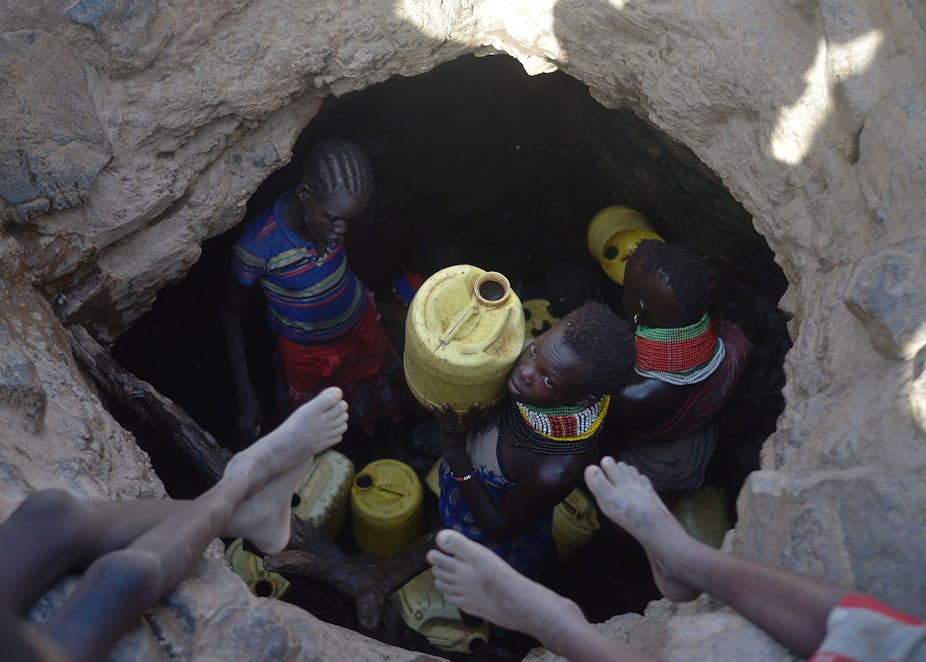All countries have a variety of water resources – some are on the surface, like rivers, and some are beneath the ground. This groundwater provides almost 50% of all global domestic use and 43% of all the water used for agriculture.
Groundwater is stored in aquifers, which come in a variety of shapes and sizes. They can be accessed in several ways, but mostly by drilling wells. Not all groundwater is useful to us – it depends on whether it’s fresh or mixed with salt and on how deep it is, as this will affect how easy it is to tap into.
In Africa, groundwater is very important. It supports almost 100% of household and agricultural activities in rural areas. And, because it’s underground it’s protected from evaporation, a crucial resource in a warming climate.
These facts and figures are in a recent World Bank report which unpacks issues facing groundwater in times of climate change. As a groundwater scientist focusing on its sustainable use, I’ve picked out some of the key issues when it comes to managing groundwater from the report. It’s vital that African countries address these as pressure increases on the continent’s water resources, through growing populations, development and changing weather patterns.
Key issues
Ownership of groundwater
Figuring out ownership of groundwater is important for the management of this finite resource. Without a clear understanding of ownership, conflict can happen.
In some countries groundwater is owned by the landowner, in others by the government. Generally, it’s being poorly managed across the continent. In many cases, boreholes used to extract groundwater aren’t even being registered.
South Africa has used laws and policies to transfer the ownership of resources to the government. But this has led to issues around red tape and licensing permits, which determine how water is allocated.
The success of permit systems depends on a thorough understanding of the resources, property owners’ compliance with granted user rights, and the enforcement of this regulation. This is particularly problematic in the developing world, according to the World Bank report.
A possible solution is decentralised management, as seen by the Qanat system in the Middle East. The system consists of a network of underground canals that transport water from aquifers in highlands to the surface at lower levels using gravity. It is normally managed by the community and financed collectively. These historical pieces of infrastructure have been abandoned in recent times, but could solve many of the water shortage issues in the semi-arid to arid areas of Africa.
Recharging aquifers
Groundwater in aquifers is finite, but it can be recharged with surface water or treated wastewater. The process also sometimes helps in the removal of harmful chemicals because the aquifer’s material can act like a very large filter.
The World Bank report highlights managed aquifer recharge as a technique which can be used to recharge aquifers. Water is either injected through a well or seeps into the ground through infiltration ponds, man-made or natural depressions in the ground which allows water to soak into the earth.
Countries in southern Africa have practised this for the past 40 years.
Aquifers can also be recharged naturally when rainwater infiltrates deep into the ground. This can be encouraged through afforestation, agricultural terraces and the prevention of land clearing. These practices allow permeable surfaces to dominate the landscape, stabilise the soil through plant growth, and slow the flow of water.
Monitoring aquifers
Monitoring aquifers is vital to know how much water is left in them. Unfortunately many African countries have poor monitoring networks and infrastructure in place. The number of monitoring points in certain countries is also dwindling, owing to financial constraints.
Satellite data can be used for monitoring. One example is the GRACE (Gravity, Recovery and Climate Experiment) twin satellites which have provided insights into subsurface water storage over the past 20 years. This means that the changes in aquifer volumes can be monitored, but only at a very large scale. It’s necessary to know what’s happening on the ground. Localised monitoring networks are needed, with data loggers at multiple wells.
Effective policies
Policies and incentives play a major role in the use of groundwater. They influence the cost of energy and abstraction and the overall accounting of groundwater resources and environmental impact.
In an African context, good policies are missing in places. There are, however, some community practices which help to protect the resource, like the Qanat system. These types of systems should be encouraged and replicated.
Groundwater dependent ecosystems
Groundwater dependent ecosystems, such as wetlands, play a critical role for many livelihoods in Africa and need to be more effectively managed. These ecosystems use groundwater to support plant and animal life and ecosystem services, such as fresh water and clean air, throughout the year.
But they’re exposed to major risks because they’re often close to semi-arid and arid areas. This is particularly true in the Sahel region. Groundwater dependent ecosystems are often close to border crossings and transport routes. Human activities, such as over-pumping, could adversely affect how they function and lead to a loss of biodiversity.
The conservation of these water bodies is of the utmost importance for the preservation of water resources and livelihoods. Policies which protect them – like the Ramsar convention – must be properly enforced. Governments could should also consider creating protected areas around some of these ecosystems.
Managing resources
It’s imperative that governments better monitor our water resources. Coupled with good practical solutions, such as managing pump rates, this will sustain groundwater resources for many years to come.
The monitoring network on our continent is unfortunately limited or non-existent in certain countries. In some, like South Africa, the network is slowly diminishing. This is unfortunate as the ability to measure allows better management of groundwater resources.

